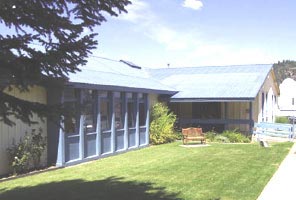
Twelve years ago, similar enthusiasm resonated in Quincy, California, where environmentalists, business interests, and loggers had come together and hammered out a plan to manage two-and-a-half national forests in northern California. The results, however, have been mostly delay and disappointment, and there is little evidence that the institutional obstacles that stymied the Quincy Library Group have been overcome. A look at the group’s history suggests that today’s public forest management hinders public participation and prevents practical and timely resolution of problems.
The Quincy Library Group (QLG) sparked headlines in the 1990s. The success of a local community coalition in putting together a logging plan for the Lassen, Plumas, and parts of Tahoe was welcomed as a sign of hope. The plan, covering an area larger than the state of Delaware (Davis and King 2000; Quincy Library Group 2005), ushered in optimism that the paralysis of public land management would be replaced by local coalition
The Quincy Library Group was preceded by fifteen years of “timber wars” over the management of the three national forests. The tumult involved court battles, alleged sabotage, and even death threats between environmentalists and logging interests (Terhune and Terhune 1998). Timber interests wanted more logging on national forests at the same time that there was growing public concern about cutting, herbicide use, logging of old-growth forests, and endangering the California spotted owl.
Timber harvests in the area peaked between the 1960s and 1980s. By 1999, harvests had fallen to 10 percent of the 1980s’ level, severely hurting the region economically. The decline was due to a multitude of factors, including falling market demand, increased opposition to logging roads, and the controversy over the California spotted owl (Terhune and Terhune 1998). Spotted owl regulations greatly affected the size of trees that were being logged. The mill near Quincy had to be retooled for smaller timber, and several other local mills closed (Marston 1997).
Ending the Stalemate
Desperate for a way out of the regulatory and litigious quagmire, an environmental lawyer, county supervisor, and timber industry forester met in secret in 1992 to explore the possibility of a truce. The meetings of these three bitter rivals eventually became public, and by 1993 the Quincy Library Group (named for its meeting place) was born. Using a decision-making approach based on unanimous consensus, the group agreed on a
compromise logging plan that same year. The plan allowed more timber to be harvested than the Forest Service was permitting at the time, although less than historical levels (Quincy Library Group 2005).
Several years of unsuccessful effort to persuade the Forest Service to adopt the plan followed. Ultimately, the group went to Congress, which enacted a law in 1998 mandating implementation of the plan as a funded pilot project. However, full implementation has been delayed, even to the present day. Environmental groups have filed lawsuits periodically, and the Forest Service has stretched out the process, partly through general delays and partly through slowing down environmental impact assessments (Little 2004).
The Quincy Library Group has a romantic David-versus-Goliath appeal, the image of disparate local interests challenging national ones. At its core, however, the group was an interest group like any other, albeit one embodying a wide diversity of interests. Nor was the plan costless. Implementation of the law was initially estimated at $83 million (Ruckelshaus Institute 1998). Even without full implementation, the Forest Service spent $82 million on activities related to the Quincy Library Group law during fiscal years 1999–2003 (HFQLG Pilot Project Implementation Team 2004). These activities included fighting wildfires, fuels reduction, and watershed restoration projects.
What Went Wrong
During the negotiations, the Forest Service apparently felt threatened by the Quincy Library Group and used passive-aggressive tactics to deal with it. Forest Service officials attended the library meetings but did not participate. Their public statements, especially to the QLG members, were very supportive, but behind the scenes they repeatedly delayed implementation (Marston 1997).
Quincy’s success in negotiating a compromise plan contrasted sharply with the agency’s own repeated failure to do so. Former Forest Service Chief Jack Ward Thomas, interviewed after retirement, stated that he disliked almost everything about the Quincy Library Group, especially the fact that Red Emmerson, the owner of Sierra Pacific Industries, a major timber company, was part of it. Thomas called Emmerson’s participation in the group “patently illegal.” He said that the Quincy Library Group was “not properly chartered, and they’re sitting there cutting deals back and forth. . . .” He resented the fact that his political bosses in Washington handed over control of two and a half national forests to an unaccountable group (Marston 1997).
National environmental groups were vociferous in their opposition. “Just because a group of local people can come to an agreement doesn’t mean that it is good public policy,” said Jay Watson of the Wilderness Society (Sagoff 2004, 221). The national groups were wary of setting a precedent for local decision making. They also questioned the management practices espoused by the Quincy plan, such as its rebreak strategy, and thought that the plan didn’t provide enough protection to the owl. Environmental groups shared the Forest Service’s view that the group had been hijacked by industry.
Bonnie Phillips of Water Watch, an observer of collaborative groups, has another criticism. She feels that the collaborative process was tainted because the Quincy Library Group went to Congress. She also contends that industry manipulated the process and objects to how the debate has been framed. In her view, it is not national environmental groups versus the grass roots, but rather national groups versus yet another special interest group controlled by industry (Marston 1997).
The Importance of The Quincy Process
The Quincy plan may not be the best plan for the forests in question. But focusing on the merits of the plan itself misses the larger picture. The Quincy experience demonstrates how difficult it is for local community members to influence the policy process, even when the government’s failure is plainly evident. The current system is so flawed and convoluted that there is rarely a meaningful way for local communities to influence policy without engaging in special interest politics. This is a clear sign of a broken democratic process.
The group has struggled for two main reasons: Not all major interest groups were represented, and the group had no actual authority. The Forest Service and national environmental groups did not meaningfully engage in the process; both had better options outside the negotiating room and each had an interest in seeing Quincy fail. The Forest Service used its regulatory and bureaucratic tools to delay the project and protect its turf; environmental groups used their time-honored tradition of relentless litigation to keep the forest management process centralized at the federal level. Both groups thought they had enough leverage to frustrate the plans of the library group. And to a large extent they did.
Perhaps these outsiders would have been more cooperative if the government had given a broad interest group a formal mandate and decision-making authority. If the collaborative process had been binding, or even partially binding, the groups that stood aside might have come to the table because the stakes would have been higher for them not to. Without some authority from the federal government, other community coalitions are doomed to suffer the same setbacks as did the Quincy Library Group.
That a community group was able to arrive at a consensus plan when the government could not is a strong endorsement of greater use of direct negotiations in federal land management. If the government cannot effectively plan then it should empower community coalitions that can.
REFERENCES
Davis, C., and M. D. King. 2000. The Quincy Library Group and Collaborative Planning within U.S. National Forests. Online: www.qlg.org/pub/Perspectives/daviskingcasestudy.htm (cited March 21, 2005).
Henry, N. M. 2005. Nearly Scrapped, Controversial Timber Sale Finds Support of Coalition. Land Letter, March 31.
HFQLG Pilot Project Implementation Team. 2004. Herger-Feinstein Quincy Library Group Forest Recovery Act Pilot Project: Status Report to Congress Fiscal Year 2003. Quincy, CA: U.S. Forest Service and U.S. Dept. of Agriculture, February 28.
Little, Jane Braxton. 2004. Court Fight over California Logging Plan. Sacramento Bee, December 2. Online.
Marston, Ed. 1997. The Timber Wars Evolve into a Divisive Attempt at
Peace. High Country News, Sept. 29. Online: www.hcn.org/servlets/hcn.Article?article_id=3656# (cited May, 2005).
Quincy Library Group. 2005. Quincy Library Group. Online. (citedMarch 21, 2005).
Ruckelshaus Institute. 1998. The Quincy Library Group. Online, (cited March 29, 2005).
Sagoff, Mark. 2004. Price, Principle, and the Environment. Cambridge: CambridgeUniversity Press.
Terhune, Pat, and George Terhune. 1998. Quincy Library Group Case Study. Online, (cited April 2, 2005).
William Varettoni was a doctoral student at the University of Maryland
School of Public Policy, where he received a master’s degree in sustainable development and conservation biology. In 2004, he was a fellow with the Kinship Conservation Institute in Bozeman. (PERC Reports previously covered the Quincy Library Group in its March 1998 issue).



